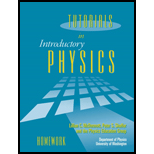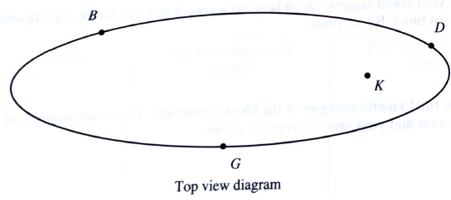
Tutorials In Introductory Physics: Homework
1st Edition
ISBN: 9780130662453
Author: Lillian C. McDermott, Peter S. Shaffer
Publisher: PEARSON
expand_more
expand_more
format_list_bulleted
Concept explainers
Textbook Question
Chapter 17.1, Problem 2bTH
For points B, D, and G, determine whether the object is speeding up, slowing down, ormoving at constant speed. Explain your reasoning. Base your answers on the work-energy theorem.
Expert Solution & Answer
Want to see the full answer?
Check out a sample textbook solution
Students have asked these similar questions
1. An arrangement of three charges is shown below where q₁ = 1.6 × 10-19 C, q2 = -1.6×10-19 C,
and q3 3.2 x 10-19 C.
2 cm
Y
93
92
91
X
3 cm
(a) Calculate the magnitude and direction of the net force on q₁.
(b) Sketch the direction of the forces on qi
(Figure 1)In each case let w be the weight of the suspended crate full of priceless art objects. The strut is uniform and also has weight w
Find the direction of the force exerted on the strut by the pivot in the arrangement (a).
Express your answer in degrees.
Find the tension Tb in the cable in the arrangement (b).
Express your answer in terms of w.
Find the magnitude of the force exerted on the strut by the pivot in the arrangement (b).
Express your answer in terms of w.
(Figure 1)In each case let ww be the weight of the suspended crate full of priceless art objects. The strut is uniform and also has weight w.
Find the direction of the force exerted on the strut by the pivot in the arrangement (b).
Express your answer in degrees.
Chapter 17 Solutions
Tutorials In Introductory Physics: Homework
Ch. 17.1 - 1. A hand pushes two blocks, block A and block B,...Ch. 17.1 - Prob. 1bTHCh. 17.1 - Prob. 1cTHCh. 17.1 - 1. A hand pushes two blocks, block A and block B,...Ch. 17.1 - Draw and label arrows on the diagram at points AG...Ch. 17.1 - For points B, D, and G, determine whether the...Ch. 17.1 - In the space provided, sketch a freebody diagram...Ch. 17.1 - Is the net work done on the block positive,...Ch. 17.1 - Consider reference frame R, moving downward with...Ch. 17.1 - List the forces exerted on the block after it has...
Ch. 17.1 - Write an expression for the net work done on the...Ch. 17.1 - Prob. 5aTHCh. 17.1 - Prob. 5bTHCh. 17.1 - Prob. 5cTHCh. 17.1 - Suppose the block in the previous problem were...Ch. 17.2 - In each question below, consider the interval that...Ch. 17.2 - In each question below, consider the balls just...Ch. 17.2 - When puck 1 crosses the second dotted line, is...Ch. 17.2 - When puck 1 crosses the second dotted line, is the...Ch. 17.2 - When puck 1 crosses the second dotted line, is the...Ch. 17.3 - When puck 1 cross second dotted line, is puck 2 to...Ch. 17.3 - Draw an arrow for each glider to represent the...Ch. 17.3 - Consider the following incorrect statement:...Ch. 17.3 - A firecracker is at rest on a frictionless...Ch. 17.3 - A block slides down a frictionless incline. The...Ch. 17.3 - Suppose the incline in part b is now placed on a...Ch. 17.3 - Two blocks, A and B. are connected by a massless...Ch. 17.3 - Prob. 3aTHCh. 17.3 - Prob. 3bTHCh. 17.3 - Draw momentum vectors of gliders A and B in the...Ch. 17.3 - Prob. 3dTHCh. 17.3 - Use your momentum vectors from part c to determine...Ch. 17.3 - Prob. 3fTHCh. 17.3 - In the table at right, draw the momentum vectors...Ch. 17.3 - Prob. 4bTHCh. 17.3 - Prob. 4cTHCh. 17.3 - Prob. 4dTHCh. 17.3 - Prob. 4eTHCh. 17.3 - Prob. 4fTHCh. 17.4 - In the space provided, draw separate arrows...Ch. 17.4 - Prob. 1bTHCh. 17.4 - In the space provided, draw separate arrows for...Ch. 17.4 - Prob. 2bTHCh. 17.4 - Construct and label a vector showing the initial...Ch. 17.4 - Object A collides on a horizontal frictionless...Ch. 17.4 - On the same horizontal surface, object C collides...Ch. 17.4 - Consider the following incorrect statement:...
Additional Science Textbook Solutions
Find more solutions based on key concepts
What is the difference between cellular respiration and external respiration?
Human Physiology: An Integrated Approach (8th Edition)
27. Consider the reaction.
Express the rate of the reaction in terms of the change in concentration of each of...
Chemistry: Structure and Properties (2nd Edition)
Why is an endospore called a resting structure? Of what advantage is an endospore to a bacterial cell?
Microbiology: An Introduction
Fibrous connective tissue consists of ground substance and fibers that provide strength, support, and flexibili...
Human Biology: Concepts and Current Issues (8th Edition)
2. List the subdivisions of the thoracic and abdominopelvic cavities.
Human Anatomy & Physiology (2nd Edition)
Distinguish between microevolution, speciation, and macroevolution.
Campbell Essential Biology (7th Edition)
Knowledge Booster
Learn more about
Need a deep-dive on the concept behind this application? Look no further. Learn more about this topic, physics and related others by exploring similar questions and additional content below.Similar questions
- A 70.0 cm, uniform, 40.0 N shelf is supported horizontally by two vertical wires attached to the sloping ceiling (Figure 1). A very small 20.0 N tool is placed on the shelf midway between the points where the wires are attached to it. Find the tension in the left-hand wire. Express your answer with the appropriate units.arrow_forwardFind the total bind Mev. binding energy for 13 Carbon, 6C (atomic mass = 13.0033554)arrow_forwardWhat is the 27 energy absorbed in this endothermic Auclear reaction 2] Al + 'n → 27 Mg + ! H? (The atom mass of "Al is 26.981539u. and that of 11 Mg is 26.984341u) MeVarrow_forward
- What is the energy released in this nuclear reaction 1 F + "', H-1 O+ He? 19 19 16 (The atomic mass of 1F is 18.998403 u, and that of 20 is 15.9949154) MeV.arrow_forwardWhat is the energy released in this B+ nuclear reaction خالد 2½ Al w/ Mg + ie? (The atomic mass of 11 Al is 23.9999394 and that > of 12 Mg is 23.985041 u) MeV.arrow_forwardWhat is the energy released / absorbed in this nuclear reaction 14 N+ & He → » O + ! N? (The atomic mass of 14 N is 14.003074u. 17N+ and that of 10 is 16.9991324). MeVarrow_forward
- Can someone help me answer this question thanks.arrow_forwardCan someone help me with this question thanks.arrow_forward4B. Four electrons are located on the corners of a square, one on each corner, with the sides of the square being 25 cm long. a) Draw a sketch of the scenario and use your sketch to b) Determine the total force (magnitude and direction) on one of the electrons from the other three?arrow_forward
- Portfolio Problem 3. A ball is thrown vertically upwards with a speed vo from the floor of a room of height h. It hits the ceiling and then returns to the floor, from which it rebounds, managing just to hit the ceiling a second time. Assume that the coefficient of restitution between the ball and the floor, e, is equal to that between the ball and the ceiling. Compute e.arrow_forwardPortfolio Problem 4. Consider two identical springs, each with natural length and spring constant k, attached to a horizontal frame at distance 2l apart. Their free ends are attached to the same particle of mass m, which is hanging under gravity. Let z denote the vertical displacement of the particle from the hori- zontal frame, so that z < 0 when the particle is below the frame, as shown in the figure. The particle has zero horizontal velocity, so that the motion is one dimensional along z. 000000 0 eeeeee (a) Show that the total force acting on the particle is X F-mg k-2kz 1 (1. l k. (b) Find the potential energy U(x, y, z) of the system such that U x = : 0. = O when (c) The particle is pulled down until the springs are each of length 3l, and then released. Find the velocity of the particle when it crosses z = 0.arrow_forwardIn the figure below, a semicircular conductor of radius R = 0.260 m is rotated about the axis AC at a constant rate of 130 rev/min. A uniform magnetic field of magnitude 1.22 T fills the entire region below the axis and is directed out of the page. R Pout (a) Calculate the maximum value of the emf induced between the ends of the conductor. 1.77 v (b) What is the value of the average induced emf for each complete rotation? 0 v (c) How would your answers to parts (a) and (b) change if the magnetic field were allowed to extend a distance R above the axis of rotation? (Select all that apply.) The value in part (a) would increase. The value in part (a) would remain the same. The value in part (a) would decrease. The value in part (b) would increase. The value in part (b) would remain the same. The value in part (b) would decrease. × (d) Sketch the emf versus time when the field is as drawn in the figure. Choose File No file chosen This answer has not been graded yet. (e) Sketch the emf…arrow_forward
arrow_back_ios
SEE MORE QUESTIONS
arrow_forward_ios
Recommended textbooks for you
 Glencoe Physics: Principles and Problems, Student...PhysicsISBN:9780078807213Author:Paul W. ZitzewitzPublisher:Glencoe/McGraw-Hill
Glencoe Physics: Principles and Problems, Student...PhysicsISBN:9780078807213Author:Paul W. ZitzewitzPublisher:Glencoe/McGraw-Hill University Physics Volume 1PhysicsISBN:9781938168277Author:William Moebs, Samuel J. Ling, Jeff SannyPublisher:OpenStax - Rice University
University Physics Volume 1PhysicsISBN:9781938168277Author:William Moebs, Samuel J. Ling, Jeff SannyPublisher:OpenStax - Rice University Classical Dynamics of Particles and SystemsPhysicsISBN:9780534408961Author:Stephen T. Thornton, Jerry B. MarionPublisher:Cengage Learning
Classical Dynamics of Particles and SystemsPhysicsISBN:9780534408961Author:Stephen T. Thornton, Jerry B. MarionPublisher:Cengage Learning
 Principles of Physics: A Calculus-Based TextPhysicsISBN:9781133104261Author:Raymond A. Serway, John W. JewettPublisher:Cengage Learning
Principles of Physics: A Calculus-Based TextPhysicsISBN:9781133104261Author:Raymond A. Serway, John W. JewettPublisher:Cengage Learning Physics for Scientists and Engineers: Foundations...PhysicsISBN:9781133939146Author:Katz, Debora M.Publisher:Cengage Learning
Physics for Scientists and Engineers: Foundations...PhysicsISBN:9781133939146Author:Katz, Debora M.Publisher:Cengage Learning

Glencoe Physics: Principles and Problems, Student...
Physics
ISBN:9780078807213
Author:Paul W. Zitzewitz
Publisher:Glencoe/McGraw-Hill

University Physics Volume 1
Physics
ISBN:9781938168277
Author:William Moebs, Samuel J. Ling, Jeff Sanny
Publisher:OpenStax - Rice University

Classical Dynamics of Particles and Systems
Physics
ISBN:9780534408961
Author:Stephen T. Thornton, Jerry B. Marion
Publisher:Cengage Learning


Principles of Physics: A Calculus-Based Text
Physics
ISBN:9781133104261
Author:Raymond A. Serway, John W. Jewett
Publisher:Cengage Learning

Physics for Scientists and Engineers: Foundations...
Physics
ISBN:9781133939146
Author:Katz, Debora M.
Publisher:Cengage Learning
Kinetic Energy and Potential Energy; Author: Professor Dave explains;https://www.youtube.com/watch?v=g7u6pIfUVy4;License: Standard YouTube License, CC-BY